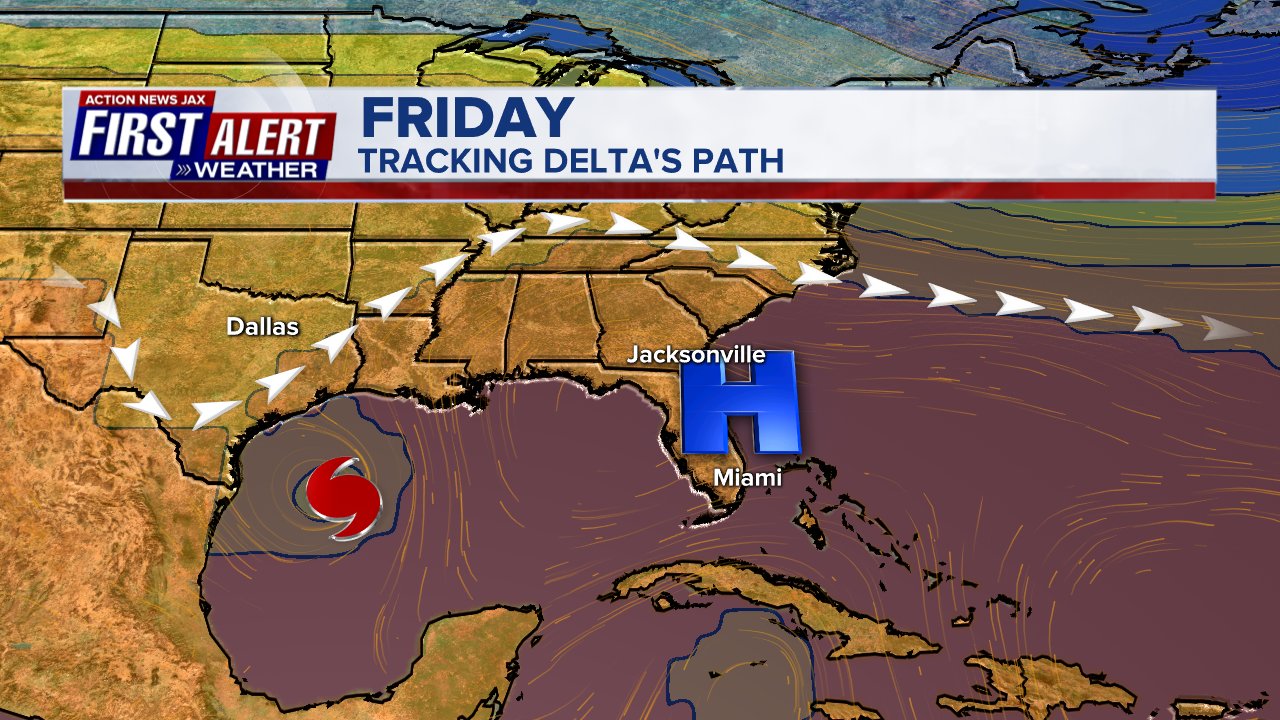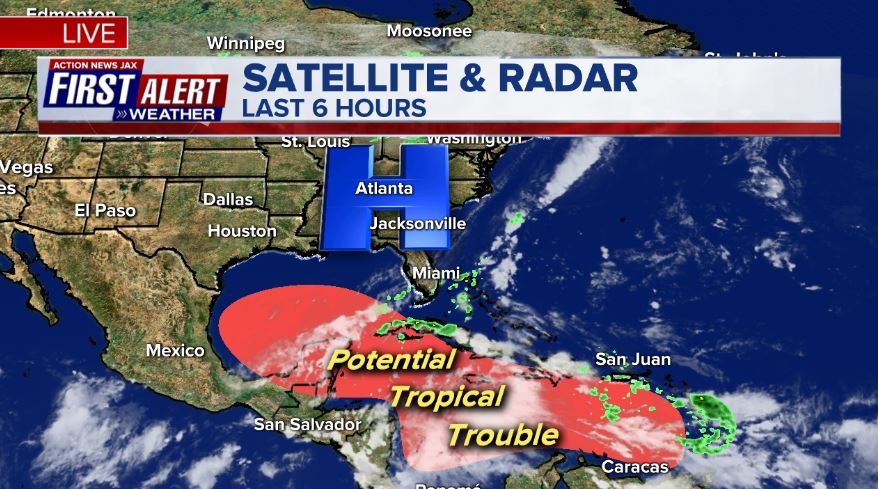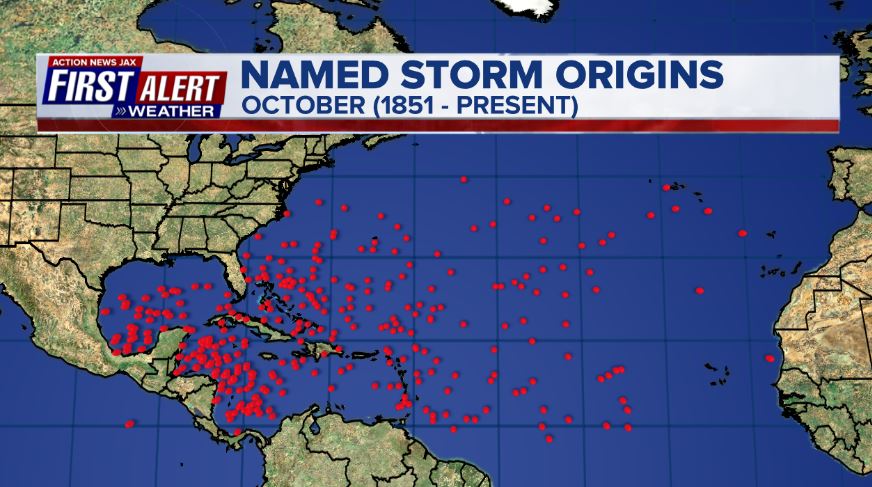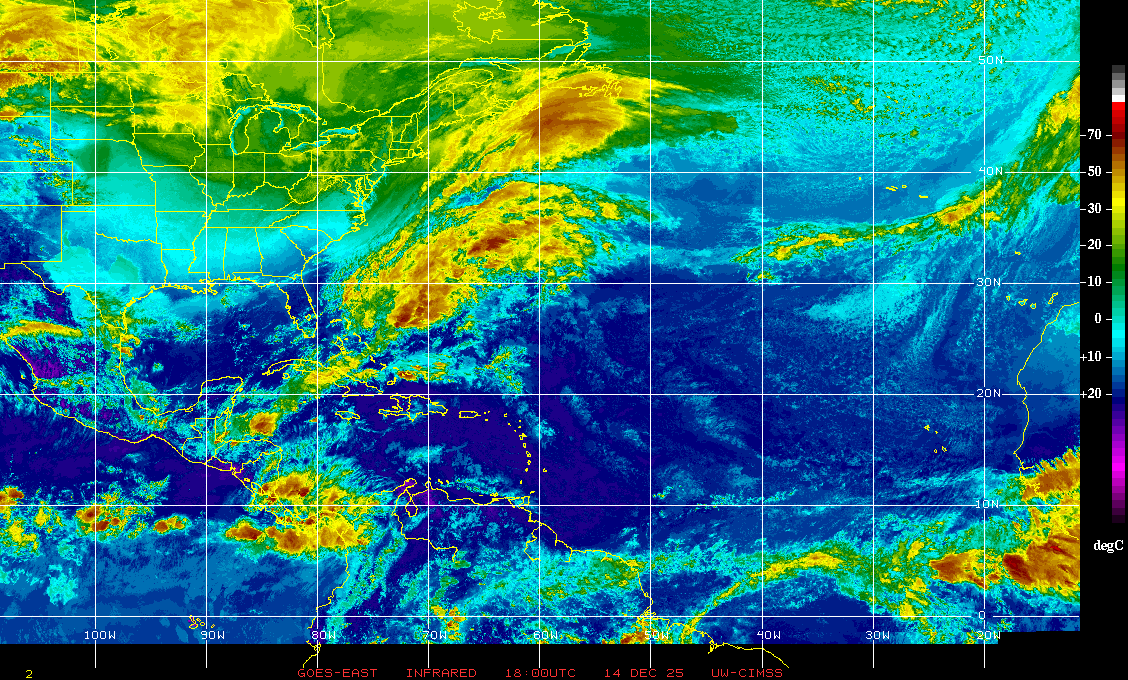Jacksonville, Fl. — The “Buresh Bottom Line”: Always be prepared!.....First Alert Hurricane Survival Guide... City of Jacksonville Preparedness Guide... Georgia Hurricane Guide.
STAY INFORMED: Get the * FREE * First Alert Weather app
FREE NEWS UPDATES, ALERTS: Action News Jax app for Apple | For Android
WATCH “Talking & Tracking the Tropics: The Science Behind the Season”
WATCH “Preparing for the Storm”
READ the First Alert Hurricane Center “Survival Guide”
***** ALWAYS CHECK & RE-CHECK THE LATEST FORECAST & UPDATES! *****
-- THERE WILL BE *NO DIRECT* IMPACTS FROM DELTA FOR JACKSONVILLE/NE FL./SE GA.....
If traveling this week/weekend to the Gulf Coast & NW Caribbean, stay informed on the latest, updated forecast......
A Caribbean tropical wave was upgraded to tropical depression #26 Sun. night... to tropical storm “Delta” early Monday then to a hurricane Monday evening while moving west/NW across the Caribbean south & southwest of Jamaica. In less than 48 hours, Delta went from a depression to a Cat. 4 hurricane by late Tue. morning. According to Phil Klotzbach, this is the fastest intensification - 70 mph in 24 hours - of an Atlantic tropical cyclone since Wilma in 2005. Like has happened so often this season, this is the fastest ever to the 25th storm beating by more than a month the previous record of Nov. 15th, - take a guess! - 2005. However, hurricane hunter aircraft along with satellite imagery indicate quite a bit of weakening by late Tue. evening. Delta may be undergoing some structural changes which *might* save Cancun from a more devastating hit.
Models had been wildly inconsistent amongst themselves not to mention compared to one another until starting to smooth out later Sunday followed by remarkable agreement the last couple of days. Special balloon launches have been scheduled across much of the South & SE U.S. in hopes of having better/more complete data (input) for the forecast models. The west/northwest movement will become more northwest through Wed./Wed. night then turning more north, followed by a northeast turn late in the week as a new upper level trough digs into the Lower 48 weakening the upper level ridge across the Northern Gulf. This upper level trough - timing, orientation & strength - will be a major player on where the tropical cyclone goes & to some extent how strong it will be. Given recent trends & typical model biases, it seems a more westward position for a longer period of time has been & will be the way to go which puts Delta near Cancun Wed. before turning more north/northwest into the Gulf then more northward/NE upon approach to the Gulf Coast. Land interaction with Yucatan should interrupt the rapid intensification cycle Wed. before “cleanly” moving over the Gulf of Mexico. Delta’s swift movement will limit its time over land & the Yucatan will be little more than a speed bump for Delta. Conditions look ripe for at least some re-strengthening once over the Southern Gulf. Models have generally slowed movement over the Gulf later in the week bringing Delta ashore Fri. afternoon or even Fri. night/early Sat. The GFS is still the fastest & more east - late Fri. afternoon west of New Orleans... the European is early Sat. over SW Louisiana not far from the Texas/Louisiana border (close to where Laura came ashore in Sept.)... & the UKMET is compromise in both timing & placement with landfall middle of the night Fri. on the Central Louisiana coast. If the center does come inland just west of New Orleans, there will potentially be a good deal of storm surge pushed into New Orleans. Actual storm surge values will - like always - be difficult to precisely forecast & will be high dependent on the location of landfall & the orientation of winds upon approach to the coast.
Currently there’s strong shear over the Gulf of Mexico on the order of 30+ mph. This shear will gradually lessen through the week as the upper level high builds to the east (near Fl.) & the upper level trough approaches from the west & northwest. While shear will start to increase at landfall, the vectors will also be in line with the direction from which Delta is moving which may mean a little less impact on the storm. Ocean temps. will not be as warm as the Caribbean/far Southern Gulf & there will also be the typical increased effects of friction upon approach to landfall. There will probably be some dry air pulled into Delta as it’s making landfall. Still.... Delta is likely to be a powerful hurricane marching steadily north/northeast on its final journey to the coast. While Delta may be off its extreme peak when it hits Louisiana & nearby areas, the hurricane is likely to still be at least a Cat. 2 if not 3 with a very dangerous storm surge near & to the east of the eye.
“Bath water” - NW Caribbean:
Meanwhile.... Tropical depression #25 formed over the Western Caribbean Fri. morning & strengthened into tropical storm “Gamma” Fri. evening & would have reached hurricane strength Sat. had it not been for landfall on the Yucatan Peninsula about 1pm EDT. It’s the fastest ever to the 24th tropical storm of the season beating the record of Oct. 27, 2005.
Quick recap: The combination of a tropical wave, lower pressures & an old front developed low pressure at the surface over the far Western Caribbean which was upgraded Fri. to t.d. #25 then tropical storm Gamma Fri. evening then back to a tropical depression late Mon. with the last NHC advisory issued Mon. night. Strong shear out of the southwest quite literally decapitated the storm, & it’s not likely to redevelop.
As I mentioned last week, dominant high pressure across northern latitudes this time of year often does yield tropical trouble that begins in or near the Caribbean.
Other tropical waves farther east will have a hard time making it all the way across the Atlantic & will be encountering increasing shear - typical later in the season.





Water vapor imagery shows a moistening atmosphere across the Gulf & in the vicinity of Delta....





The upper level (500 mb) forecast for Friday shows the approaching trough that will help steer & accelerate Delta north then northeast around the western edge of the upper level high over & near Fl. (our “protector”):
Persistent, broad & strong high pressure at northern latitudes helping to induce low pressure at lower latitudes:
October tropical cyclone origin points are clustered over the Caribbean, Gulf of Mexico & SW Atlantic:
Atlantic Basin wave forecast for 24, 48 & 72 hours respectively (major wave action at Fl./Ga. beaches through early next week due to persistent brisk onshore flow (high pressure to the north) combined with easterly swells from distant Teddy:








:quality(70)/cloudfront-us-east-1.images.arcpublishing.com/cmg/WW5AJL3ARQUGDQMAQUNSFX4CLE.jpg)






















:quality(70)/cloudfront-us-east-1.images.arcpublishing.com/cmg/VIBAZNKLLZFBDI54LSHBQPENAA.png)
:quality(70)/cloudfront-us-east-1.images.arcpublishing.com/cmg/NGMKLAKH5NF27JQOAGV7JN25OU.jpg)
:quality(70)/d1hfln2sfez66z.cloudfront.net/04-28-2024/t_c7204efb6774424b8fc4cd0b9d066d68_name_file_960x540_1200_v3_1_.jpg)
:quality(70)/cloudfront-us-east-1.images.arcpublishing.com/cmg/4HHTP2EADNFKNEYWPXQPRZT5XE.jpg)
:quality(70)/d1hfln2sfez66z.cloudfront.net/01-16-2023/t_1f852e6223cd4a1495e39af4b9acb7f1_name_file_960x540_1200_v3_1_.jpg)